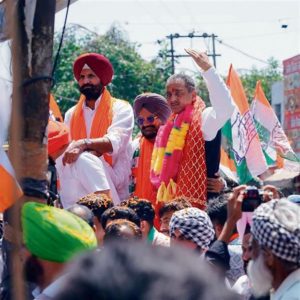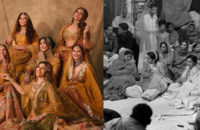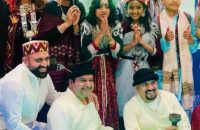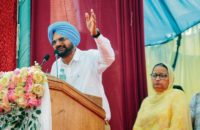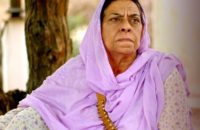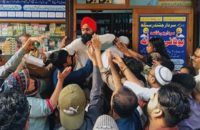A group of young volunteers is working at Calgary’s Dashmesh Culture Centre to help Sikh seniors with safety and proper mask use, which is an issue for some in the community.
Some men struggle with their beards and turbans when it comes to wearing a mask correctly, and can also find it difficult to access the protective equipment and information they need to stay safe.
Volunteers with two groups, Sikhs Doing Seva and Sikh Heritage Alberta, have set up a table inside a local Sikh temple to connect seniors, who are the most vulnerable in their community, with the right information and equipment, including disposable masks.
It’s part of the Alberta South Asian COVID-19 Relief Project, which also aims to provide health information in Punjabi.
“Our whole goal is to educate our community, because personal protective equipment for minority communities is not always as accessible,” said volunteer Isha Kaur.
How this little plastic clip is helping those with turbans stay safe during the pandemic18 hours agoVideo
0:15
A volunteer group in the Punjabi community in Calgary is trying to educate how people can wear masks properly and still maintain their religious identity. There were concerns masks were getting in the way of turbans and hijabs, but a simple plastic clip is allowing people to wear both. 0:15
“It’s so they can protect themselves and others and properly understand how to wear a mask.”
Some seniors have been spotted walking up to the temple wearing bandanas and scarves instead of proper masks, which offer much more protection.
“The intention to protect the community is there, but there’s just a lack of education,” said Kaur.
She said the seniors are trying their best but some need help.
3-layer mask ‘possible with religious wear’
Kaur said some minority communities have been blamed for the spread of coronavirus cases in Alberta and across Canada. She said she wants to help address that and limit any stigma.
“A proper three-layer mask is possible with religious wear. We suggest they don’t wear masks that are less than three layers, as per Alberta Health guidelines,” said Kaur.
Volunteer Isha Kaur says the Alberta South Asian COVID-19 Relief Project is about protecting seniors and improving accessibility to protective equipment in the community. (Dan McGarvey/CBC)
A three-layer mask can be a non-medical cotton mask as well as the popular blue disposable masks, which are being handed out by volunteers.
Volunteer Jasleen Brar said balancing the issue of religious identity with COVID safety is important to South Asian communities.
One small innovation that appears to be helping is a simple plastic clip that connects mask strings behind the neck instead of behind the ears, which can be near-impossible when wearing religious head coverings like turbans and hijabs.
“We designed these clips so that someone wearing a turban or a hijab can still wear them and still have an appropriate face covering,” said Brar.
“We find that immigrant communities are blamed for not following guidelines, but we should understand how we can better offer personal protective equipment as well as how to educate the community,” said Brar.
‘They are important to us’
There are also language barriers and accessibility issues for South Asian seniors.
Kaur said being able to talk to seniors in their own language is a huge help when it comes to getting vital information across about how to wear masks in the most effective way.
“When you’re from within the community, it makes it a lot easier,” she said.
She adds that so far, the response has been positive.
Amanpreet Singh Gill, president of Dashmesh Culture Centre, said there have been problems with Sikh seniors wearing masks incorrectly or improvising with bandannas and scarves, which don’t offer the same protections as a three-layer mask. (Dan McGarvey/CBC)
Amanpreet Singh Gill, president of the Dashmesh Culture Centre, said seniors need more help than others because they are the most at-risk group and often have the most limited language skills.
“The death rate is high for them, and they are important to us,” Gill said.
The volunteers will return to the temple on the second weekend of February.
They hope to roll out the same initiative in Edmonton.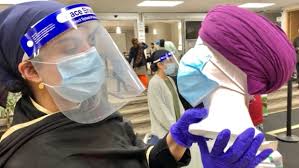




 Canada Uber Driver Tells Passenger He Would Have ‘Kidnapped Her If It Was Pakistan’
Canada Uber Driver Tells Passenger He Would Have ‘Kidnapped Her If It Was Pakistan’






